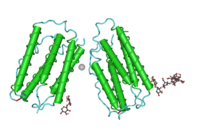
Photo from wikipedia
Avoiding interferon avoidance Interferon (IFN) expression is a mammal's first response to viral infection. Many viruses have thus evolved mechanisms to evade IFN. Du et al. developed a method to… Click to show full abstract
Avoiding interferon avoidance Interferon (IFN) expression is a mammal's first response to viral infection. Many viruses have thus evolved mechanisms to evade IFN. Du et al. developed a method to systematically ablate IFN evasion genes from live, attenuated influenza virus (see the Perspective by Teijaro and Burton). A combination of mutants was assembled to construct a virus that triggered transient IFN responses in mice but that was unable to replicate effectively. The transient IFN responses led to robust antibody and memory responses that protected against subsequent challenge with different influenza viruses. This approach could be adapted to improve other RNA virus vaccines. Science, this issue p. 290; see also p. 277 High-throughput genomics can be used to retune attenuated viruses to optimize vaccine development. In conventional attenuated viral vaccines, immunogenicity is often suboptimal. Here we present a systematic approach for vaccine development that eliminates interferon (IFN)–modulating functions genome-wide while maintaining virus replication fitness. We applied a quantitative high-throughput genomics system to influenza A virus that simultaneously measured the replication fitness and IFN sensitivity of mutations across the entire genome. By incorporating eight IFN-sensitive mutations, we generated a hyper–interferon-sensitive (HIS) virus as a vaccine candidate. HIS virus is highly attenuated in IFN-competent hosts but able to induce transient IFN responses, elicits robust humoral and cellular immune responses, and provides protection against homologous and heterologous viral challenges. Our approach, which attenuates the virus and promotes immune responses concurrently, is broadly applicable for vaccine development against other pathogens.
Journal Title: Science
Year Published: 2018
Link to full text (if available)
Share on Social Media: Sign Up to like & get
recommendations!